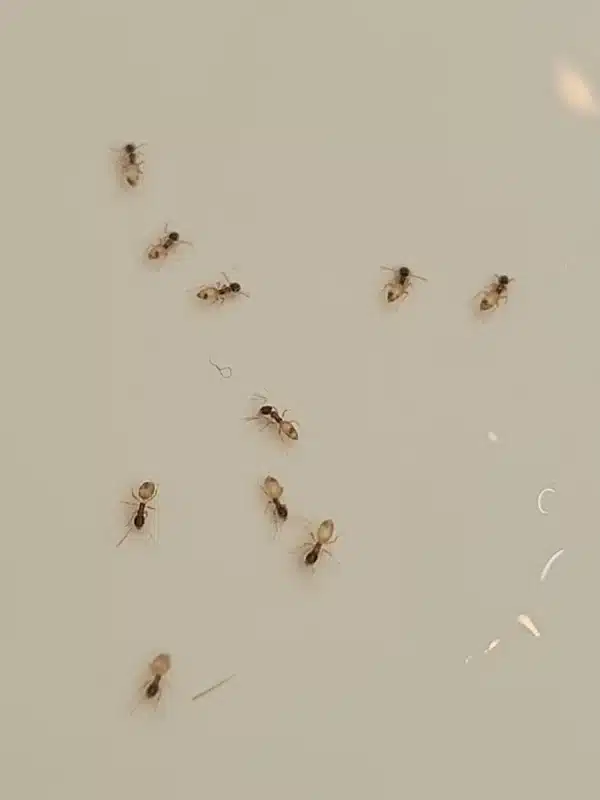Finding ants marching across your bathroom sink or around your bathtub can be both surprising and frustrating. Many homeowners expect to see ants in the kitchen, but the bathroom? That’s often the last place you’d think to look. Yet in my years of helping homeowners, I’ve found that bathroom ant infestations are incredibly common, especially during spring and summer months.
The truth is, your bathroom creates the perfect environment for ant activity. Between moisture from showers, soap residue, and tiny cracks around plumbing, ants have everything they need to thrive. Understanding why are there ants in my bathroom is the first step toward getting rid of them for good.
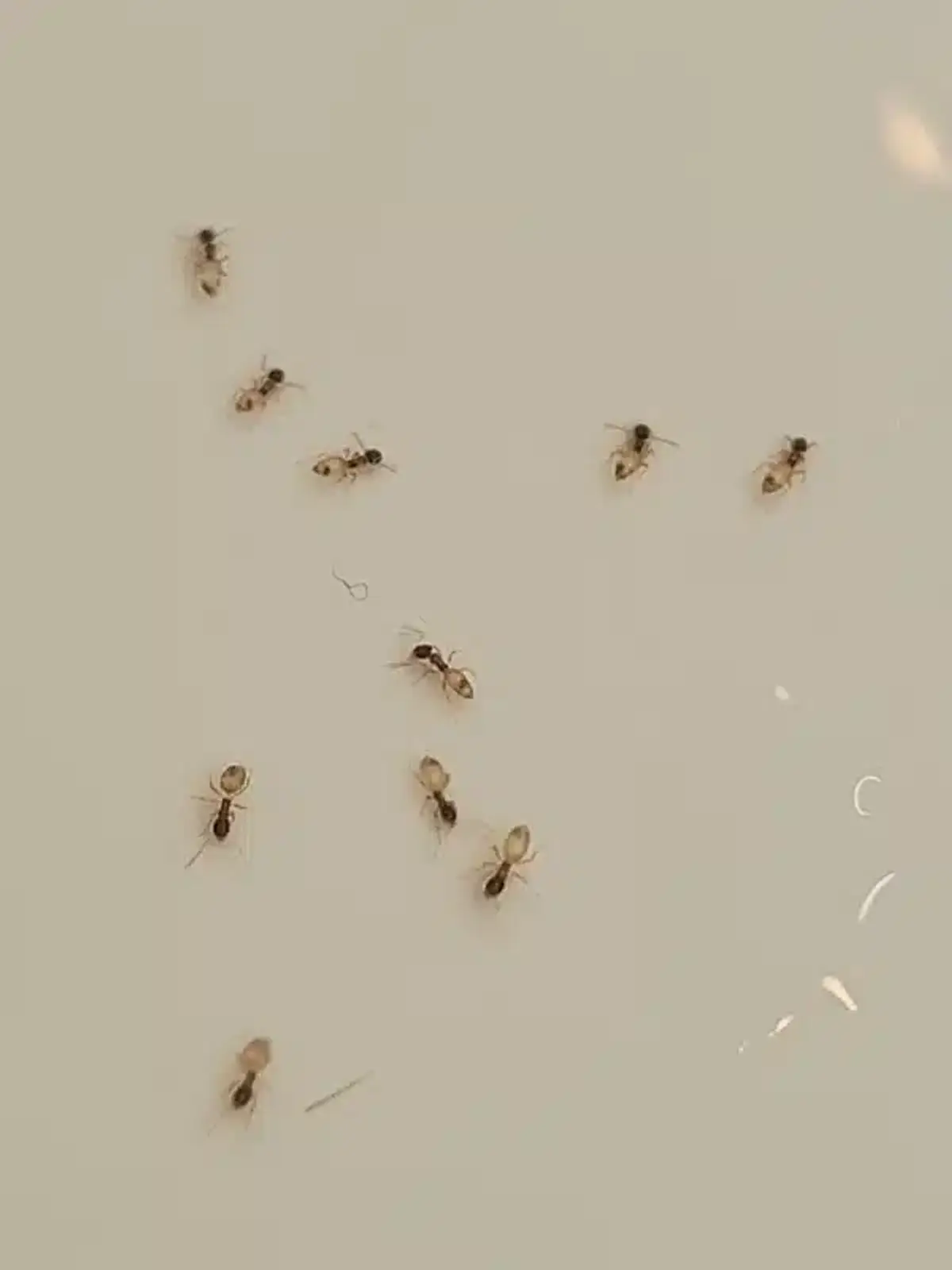
Understanding Why Ants Choose Your Bathroom
When homeowners ask me “why are there ants in my bathroom,” I always explain that it comes down to three basic ant needs: water, food, and shelter. Your bathroom provides all three in abundance.
Moisture: The Primary Attraction
Most ant species require a steady water source to survive. According to The Spruce, bathrooms supply this through multiple sources including shower condensation, dripping pipes, and wet towels. Even small amounts of standing water from a leaky P-trap or toilet supply line can attract entire colonies.
In my experience, even homeowners who think their bathrooms are completely dry often have hidden moisture issues. I’ve found ant trails leading to minor plumbing leaks behind vanities that homeowners didn’t even know existed.
Food Sources You Might Not Consider
While bathrooms don’t have obvious food like kitchens do, they offer plenty of organic matter that ants find appealing. Soap scum contains fats and oils, while toothpaste provides glycerin and sugars. Additionally, shed hair and skin cells supply the proteins ants need.
Personal care products like shampoo and body wash leave residues that ants can detect and follow. Even a small dollop of toothpaste near the sink can create a trail that leads dozens of ants directly to your bathroom.
Perfect Climate Conditions
The warm, humid environment in most bathrooms creates ideal conditions for ant activity. When humidity levels stay above 60%, ant pheromone trails last longer, making it easier for workers to communicate and recruit more ants to the area.
Common Entry Points: How Ants Get in Your Bathroom
Understanding where ants enter your bathroom helps explain why are there ants in my bathroom appearing seemingly out of nowhere. These tiny insects are remarkably skilled at finding even the smallest openings.
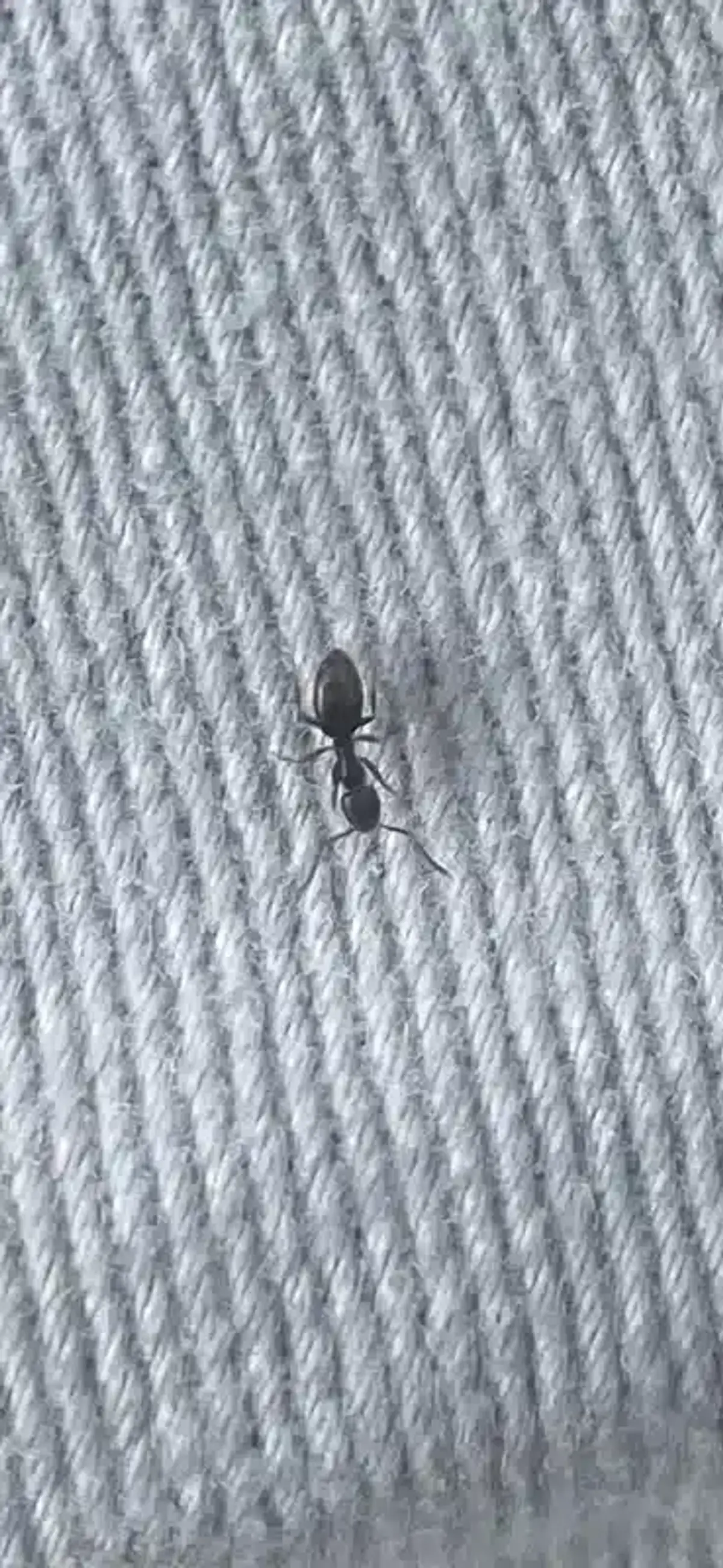
Plumbing Penetrations and Gaps
The spaces around pipes where they enter walls or floors create natural highways for ants. Over time, caulk and foam sealants can shrink or crack, leaving gaps that are invisible to homeowners but obvious to ants.
I frequently find ant entry points around toilet supply lines, shower valve penetrations, and areas where pipes pass through bathroom floors. These spots often have slight gaps that allow both moisture and ants to move freely.
Damaged Grout and Caulk
Failed caulk around bathtubs and shower enclosures doesn’t just let water through - it creates perfect ant highways. Cracked tile grout provides similar access points, especially in older bathrooms where settling has created gaps.
Window frames and vent openings also develop small cracks over time. During spring months especially, I see increased ant activity as outdoor colonies become more active and start exploring these potential entry points.
Case Study: Hidden Entry Point Discovery
The Mystery Behind the Vanity
A homeowner contacted us about persistent ants appearing near their bathroom sink every morning, despite their bathroom being spotless. Initial inspection found no obvious entry points or moisture issues.
- Initial signs: 5-10 ants appearing daily near sink faucet
- Obvious sources ruled out: No visible leaks, clean surfaces, properly sealed windows
- The discovery: Tiny gap behind vanity where supply line entered wall
- Hidden problem: Minor condensation from AC unit above was dripping behind the wall
This case taught me that ant problems often stem from moisture sources and entry points that aren’t immediately visible. Thorough inspection behind fixtures is essential for long-term ant control success.
Types of Ants Commonly Found in Bathrooms
Not all ants are created equal when it comes to bathroom infestations. Different species have different preferences, and identifying which type you’re dealing with helps determine the best treatment approach.
Odorous House Ants
These are probably the most common ants I encounter in bathroom situations. Odorous house ants are attracted to sugary substances and moisture. When crushed, they release a distinctive coconut-like smell that gives them their name.
These ants are particularly drawn to toothpaste residue and sweetened personal care products. They’re also excellent at following moisture trails, which explains why they often appear around bathroom sinks and tubs.
Pavement Ants
Pavement ants often nest in soil under concrete slabs and find their way into bathrooms through expansion joints and foundation cracks. According to University of Maryland Extension, these ants are particularly active in spring as outdoor temperatures warm up.
In bathrooms, pavement ants tend to follow the edges of tiles and baseboards. They’re attracted to both moisture and organic debris that accumulates in these areas.
Pharaoh Ants
These tiny yellow ants are particularly problematic because they can establish multiple colonies throughout a building. Pharaoh ants are drawn to warm, humid conditions, making bathrooms ideal nesting locations.
What makes pharaoh ants especially concerning is their ability to carry bacteria and pathogens. WebMD reports that these ants can mechanically carry over 12 human pathogens, including Salmonella and Staphylococcus.
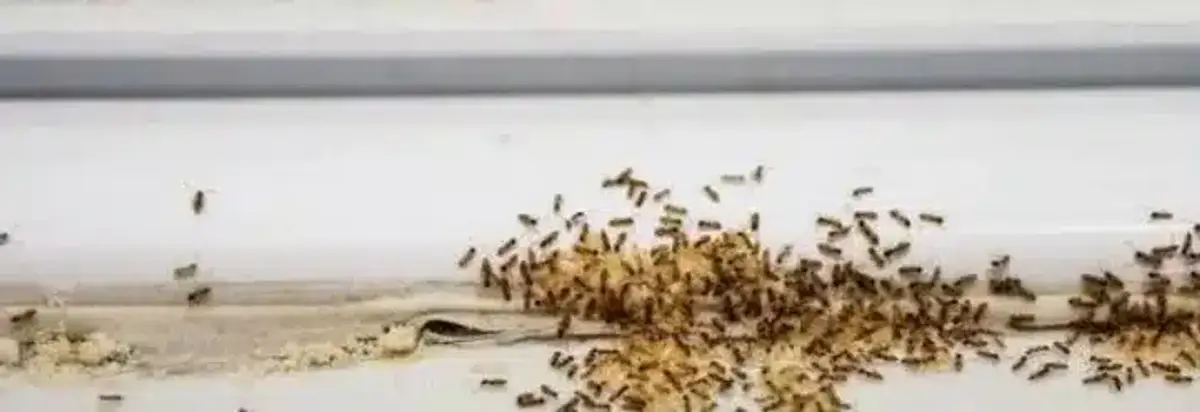
Carpenter Ants
While less common than other species, carpenter ants in bathrooms often signal a more serious problem. These large black or dark brown ants are attracted to moisture-damaged wood around tubs, windows, or subfloors.
When I find carpenter ants in a bathroom, it’s usually a sign of hidden moisture damage that needs immediate attention. Unlike other ants that are simply foraging, carpenter ants may actually be nesting in water-damaged structural elements.
Health and Property Concerns from Bathroom Ants
While finding ants in your bathroom is primarily a nuisance, there are some legitimate health and property concerns to consider, especially with certain species.
Disease Transmission Risks
Most common bathroom ants like odorous house ants and pavement ants pose minimal direct health risks. However, pharaoh ants are different. These tiny ants can pick up bacteria from drains, trash, and other contaminated areas, then transfer them to clean surfaces.
The risk is generally low in residential settings, but it’s worth noting that proper hygiene becomes even more important when dealing with any ant infestation in areas where you practice personal care.
Structural Indicators
Carpenter ants in bathrooms often indicate moisture problems that can lead to serious structural issues. These ants don’t actually eat wood, but they excavate galleries in water-softened lumber around windows, subfloors, and wall framing.
Finding carpenter ants doesn’t necessarily mean your house is falling apart, but it’s definitely a signal to investigate potential moisture problems before they become bigger issues.
Effective Ant Control Methods for Your Bathroom
Successfully answering “why are there ants in my bathroom” leads directly to effective treatment strategies. The most successful approach combines multiple methods rather than relying on a single solution.
Moisture Control and Sanitation
The foundation of any successful ant treatment is eliminating the conditions that attracted them initially. This means fixing leaks, improving ventilation, and removing organic debris.
Run your exhaust fan for at least 30 minutes after showering to reduce humidity levels. Fix any dripping faucets or toilet supply lines immediately. Remove soap scum, toothpaste residue, and hair from surfaces regularly.
I always tell homeowners that you can kill individual ants all day long, but until you address the underlying moisture and food sources, you’ll keep seeing new ones appear.
Exclusion and Sealing
Once you’ve eliminated attractants, the next step is preventing new ants from entering. This involves carefully sealing potential entry points around your bathroom.
Use flexible caulk or sealant around plumbing penetrations, window frames, and tile-to-tub joints. Pay special attention to areas where different building materials meet, as these often develop gaps over time.
For areas that need to remain somewhat flexible, like expansion joints, use appropriate sealants that can accommodate building movement without cracking.
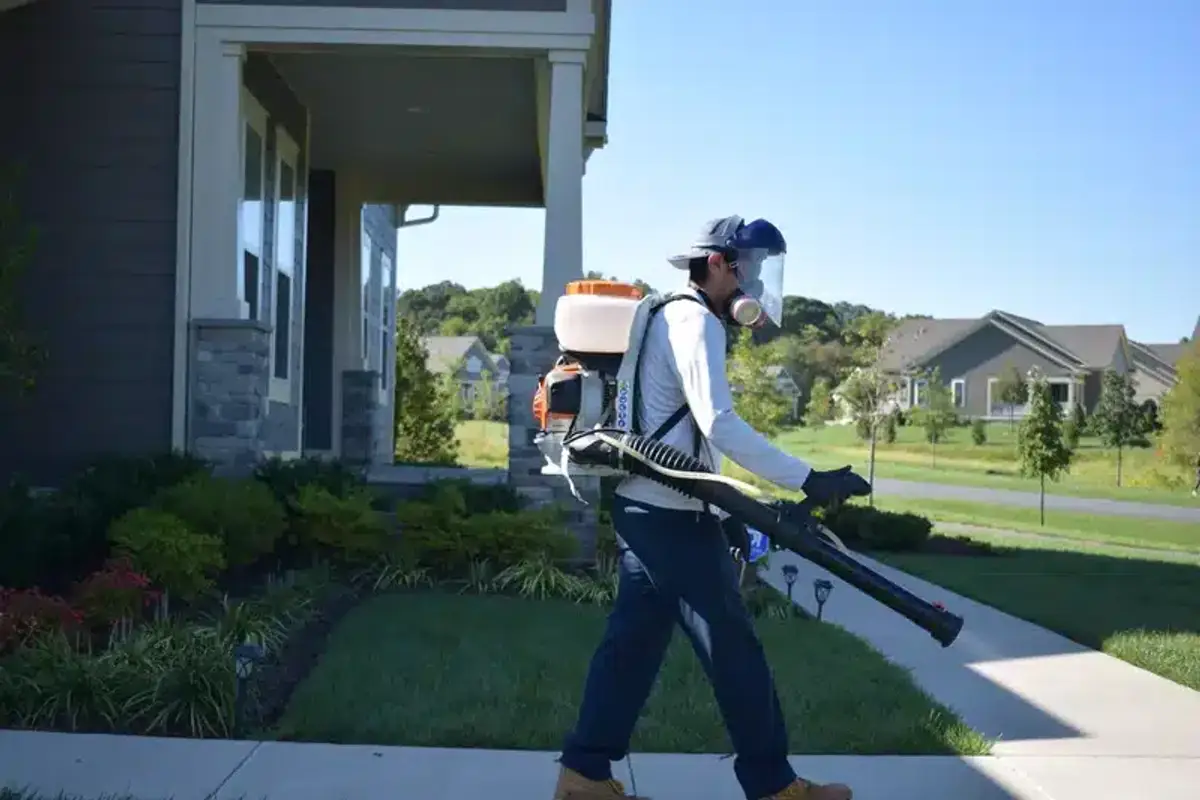
Targeted Baiting Systems
Baits are often the most effective long-term solution for bathroom ant problems. Unlike sprays that only kill individual ants, baits allow worker ants to carry the active ingredient back to their colony.
Sugar-based baits work well for odorous house ants, while protein or grease-based options may be more effective for pavement ants. The key is placing multiple bait stations along ant trails and being patient - it can take 24-48 hours to see significant results.
Avoid using repellent sprays near bait stations, as this can prevent ants from accessing the bait and carrying it back to their nest.
Professional-Grade Treatments
For persistent problems or situations involving pharaoh ants, professional treatment often provides the most reliable results. Licensed technicians can use non-repellent insecticides that ants can’t detect, allowing them to contact treated surfaces and spread the material throughout their colony.
Professional treatments also include thorough inspection to identify moisture sources and entry points that homeowners might miss. This comprehensive approach addresses both immediate ant activity and underlying conditions.
Ant Treatment Method Comparison
| Baiting Systems | Spray Treatments | Professional Service | |
|---|---|---|---|
| Effectiveness | Colony elimination | Individual ants only | Comprehensive solution |
| Timeline | 24-48 hours | Immediate but temporary | 1-2 weeks complete |
| Cost | Low ($10-30) | Low ($5-15) | Moderate ($150-300) |
| Best For | Most situations | Emergency cleanup | Persistent problems |
Natural Ant Control Options for Bathrooms
Many homeowners prefer to start with natural approaches when dealing with bathroom ant problems. While these methods may require more frequent application, they can be effective for minor infestations.
Essential Oil Deterrents
Essential oils can provide natural ant control for homeowners who prefer non-chemical approaches. Peppermint and spearmint oils show particular promise as natural deterrents when used at proper concentrations.
What does the science say?
Research published in Discover Applied Sciences demonstrates that peppermint and spearmint essential oils can effectively repel or even kill certain ant species at concentrations of 10% or higher. The study found these oils disrupt ant pheromone trails and can cause mortality in direct contact situations, making them viable alternatives to synthetic pesticides for minor infestations.
To create a natural ant deterrent, mix 10-20 drops of peppermint oil with half a teaspoon of dish soap in 250ml of water. Apply this mixture to ant trails and entry points, but remember that essential oils break down quickly and need frequent reapplication.
Boric Acid-Based Solutions
Boric acid baits can be effective against many bathroom ant species. Mix small amounts of boric acid with sugar or cornmeal to create attractive baits. However, use these products carefully in bathrooms where children or pets have access.
Place boric acid baits in areas where you’ve observed ant activity, but away from areas where they might contaminate personal care items or come into contact with children.
How to Prevent Ants in Your Bathroom
The best approach to bathroom ant problems is preventing them entirely. Once you’ve solved an existing infestation, implementing good prevention practices keeps ants from returning.
Regular Maintenance and Inspection
Check caulk and grout lines annually for cracks or gaps. Inspect under sinks and around toilets for minor leaks that might not be immediately obvious. Even small drips can create enough moisture to attract ant scouts.
During spring months when ant activity increases, pay extra attention to potential entry points. A small investment in preventive caulking can save significant frustration later.
Essential Bathroom Ant Prevention Steps
- Moisture Control: Run exhaust fans for 30+ minutes after showers, fix leaks immediately, and maintain humidity below 60%
- Entry Point Sealing: Inspect and re-caulk plumbing penetrations, window frames, and tile-to-tub joints annually
- Surface Cleaning: Remove soap scum, toothpaste residue, and hair from all surfaces weekly
- Regular Inspections: Check under sinks, around toilets, and behind vanities for minor leaks monthly
- Ventilation Upgrades: Consider higher-capacity exhaust fans if current ventilation seems inadequate
Humidity and Ventilation Management
Keep bathroom humidity below 60% when possible by using exhaust fans effectively. Consider upgrading to a higher-capacity fan if current ventilation seems inadequate.
Hang towels and bath mats where they can dry completely rather than leaving them in damp piles. Remove standing water from soap dishes, toothbrush holders, and shower corners.
When to Call Professional Pest Control Services
While many bathroom ant problems can be resolved with DIY approaches, certain situations warrant professional intervention. Knowing when to make that call can save time and prevent minor problems from becoming major infestations.
If you’ve tried multiple treatment approaches over several weeks without seeing improvement, it’s time to bring in licensed technicians. Similarly, if you’ve identified the ants as pharaoh ants, professional treatment is almost always necessary due to their complex colony structure.
Carpenter ants in the bathroom definitely warrant professional assessment, as they may indicate hidden moisture damage that requires both pest control and potential repairs.
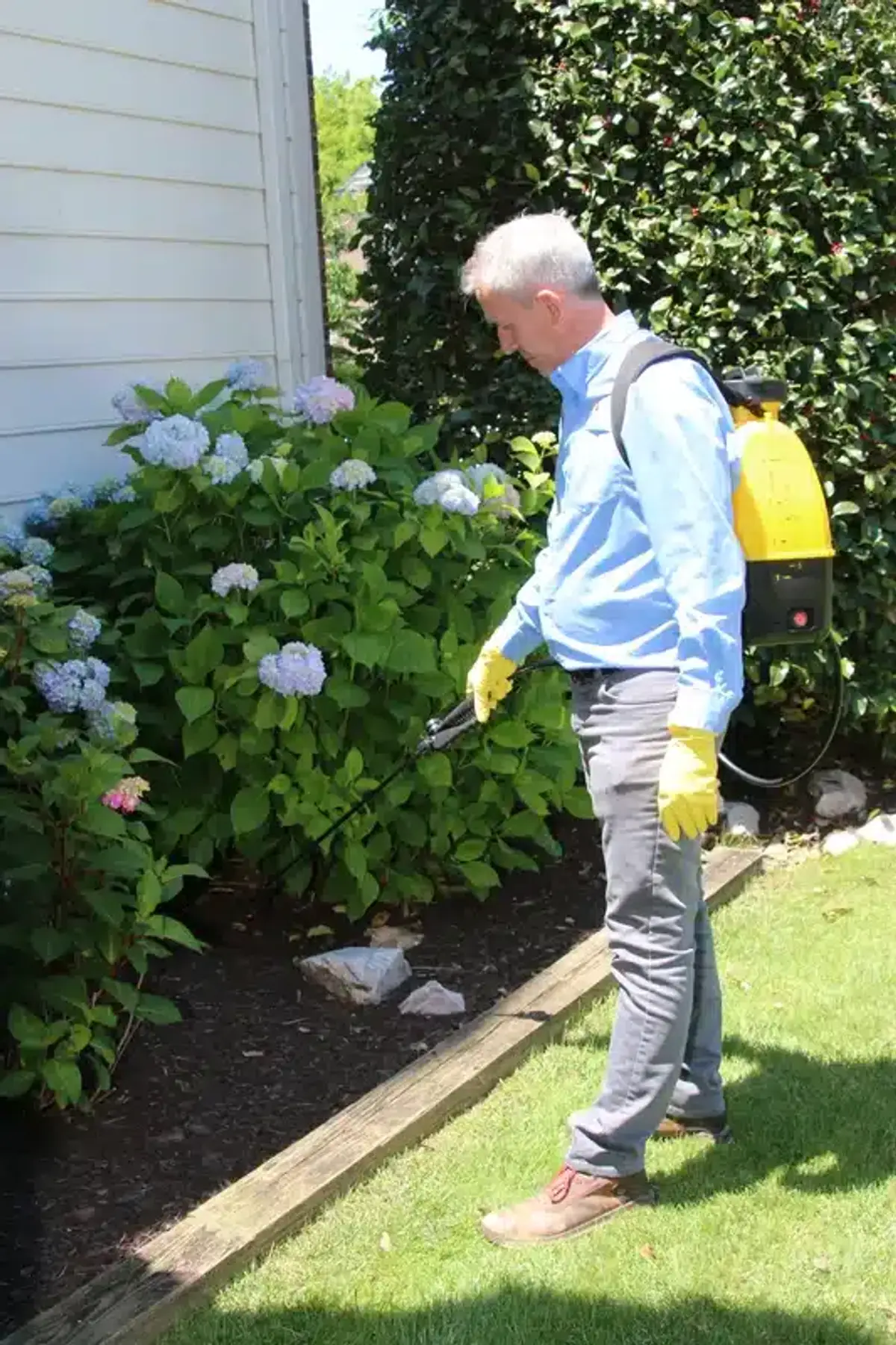
Our registered technicians begin with a thorough inspection to identify ant species, locate entry points, and assess moisture conditions. We use EPA-approved products that have passed through our internal research team - products we’d feel comfortable using in our own homes.
For ongoing protection, we establish tri-annual maintenance visits (three times per year) because most ant control materials have a maximum effective period of around 90 days. If you spot ant activity between scheduled visits, we’ll return at no additional cost until the problem is resolved.
Bathroom ant infestations can be frustrating, but they’re definitely solvable with the right approach. By addressing moisture issues, sealing entry points, and using appropriate treatment methods, you can eliminate current problems and prevent future ones. If you’re dealing with persistent ants or want professional assessment of your situation, give us a call at 703-683-2000 or email us at info@bettertermite.com for expert help tailored to your specific needs.
Frequently Asked Questions
Here are the most common bathroom ant questions we hear from homeowners in the DMV.
Why do I suddenly have ants in my bathroom?
+
Sudden ant appearances often result from changes in moisture levels, seasonal activity increases, or recently developed entry points. Spring and summer months bring increased ant activity as outdoor colonies become more active and scout for resources.
Can ants come up through bathroom drains?
+
While ants occasionally appear near drains, they typically don't travel through the water-filled P-traps under sinks and tubs. They're more likely entering through gaps around drain penetrations or nearby plumbing openings.
What attracts ants to clean bathrooms?
+
Even spotless bathrooms can attract ants due to moisture from showers and minor residues from soap, toothpaste, or personal care products. Condensation and humidity levels above 60% create ideal conditions regardless of visible cleanliness.
Are bathroom ants dangerous?
+
Most bathroom ants pose minimal health risks. However, pharaoh ants can carry bacteria and pathogens, while carpenter ants may indicate moisture damage that could lead to structural problems if left unaddressed.
How long does it take to eliminate bathroom ants?
+
With proper baiting systems, you should see reduced activity within 24-48 hours and significant improvement within one week. Complete elimination typically takes 2-4 weeks depending on colony size and species.
Will fixing the moisture problem alone eliminate ants?
+
Addressing moisture issues is crucial, but it won't remove existing colonies. Combine humidity control with targeted baiting or professional service to fully eliminate the infestation.
With five years of hands-on experience in the pest control industry, George Schulz is a registered technician with the Virginia Pest Management Association and a proud third-generation professional in a family business that's been protecting homes for over 57 years. He manages and trains a team of service pros while also leading internal research efforts—recently spearheading a deep-dive review of thousands of documents on pest control materials to hand-pick the most kid and pet friendly, most effective solutions tailored specifically for homes in the DC metro area.
